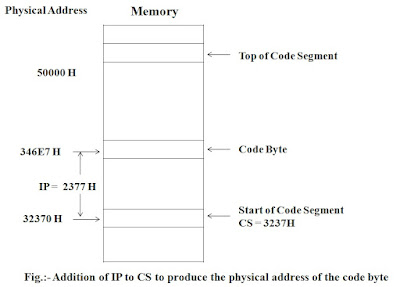Memory segmentation:
The 8086 microprocessor is capable of accessing 1MB of memory. The memory is segmented into 4 parts called as
1) Code segment: Used to store program code.
2) Data segment: used to store data.
3) Extra segment: Also used to store dada whenever the size of data is large.
4) Stack segment: Used to return addresses in case of interrupt related operation.
The size of each segment is 64kb. At a particular time 8086 can work with 4 segments.
The
base address of each segment is stored in segment registers. For generating 20
bit physical address of 8086 adds an offset address (distance from base) with
base address. For each segment there is default pair of registers in which base
& offset address. Table below shows these default pairs.
|
Segment (Base Address) |
Offset |
Special Purpose |
|
CS |
IP |
Instruction address |
|
DS |
BX, DI, SI, 8/16 Bit Number |
Data
address |
|
SS |
SP/BP |
Stack Address |
|
ES |
DI |
String destination address |
20-bit Physical address generation / Real mode memory addressing
The
memory of 8086 is segmented into 4 different parts i.e. code segment, data
segment, extra segment and stack segment. The size of each segment is 64KB. The
maximum size of internal registers of 8086 is 16 bits. Therefore, we can store
maximum 16-bit address of memory in internal registers of 8086, by using 16 bit
address we can address up to 64KB memory (216 = 64 KB). But for
reading or writing code & data from memory 8086 outputs 20 bit physical
address to memory. Therefore in 8086, 20-bit physical address is generated by
adding two 16-bit logical addresses. (Logical addresses are those addresses
that are used in program). Figure below shows this.
The base address in segment register is shifted to left by 4-bits by adding a zero at LSB position of base address. Since these 4 bits are inserted by Microprocessor automatically they are called as hard wired zeros.








3 Comments
Thanks
ReplyDelete😂😂
ReplyDeleteThank you 😊
ReplyDelete